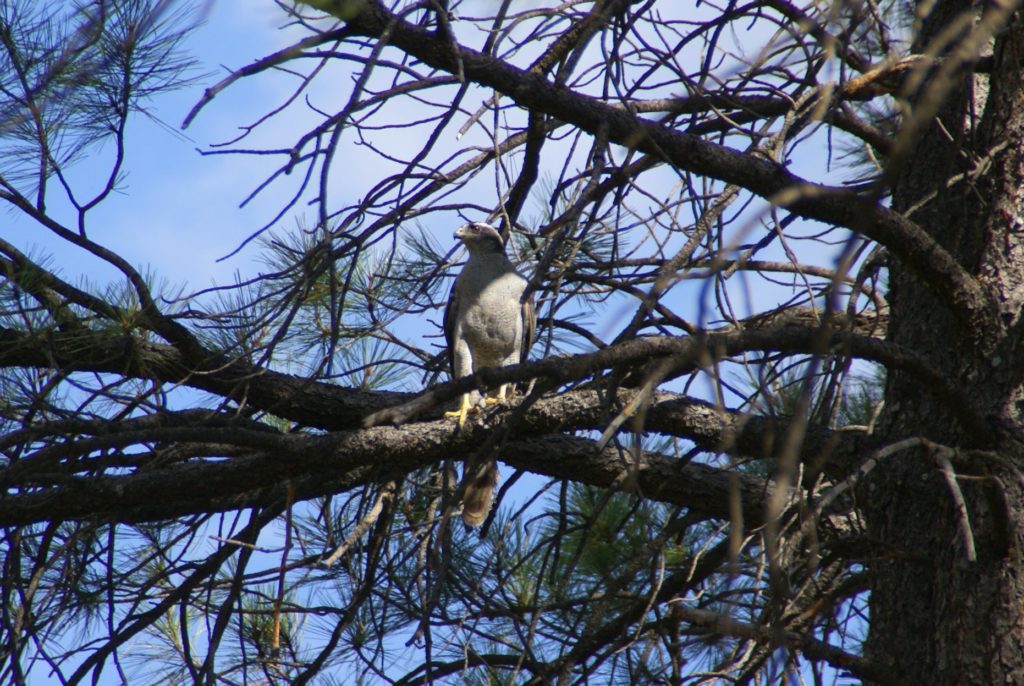by Jon Mobeck, Executive Director
This is the story of an elusive and magnificent bird, and a story of a walk in the woods. They are connected.
I enjoy wandering in the forest, looking and listening for things. I’m not alone.
One morning recently, I parked at the trailhead, pulled out my phone and tapped the Audubon Birds Pro app. Before I entered this particular mixed forest of aspen and conifer, I wanted to familiarize myself once more with the calls of the bird I hoped to find.
Northern Goshawk (Accipiter gentilis). Family: Hawks and Eagles. Description: 20-26” (51-66 cm). W. 3’ 6” (1.1 m). Adult distinctive if seen well, gray-barred below, with black face, sharp white eyebrow. Voice: Loud kak-kak-kak-kak-kak when disturbed.
One more time. Kak-kak-kak-kak-kak. Listen. OK. Got it.
As I start walking, I don’t want to play the sound anymore since it can be disruptive to birds – and to me, since I want to be present here. But I do replay the goshawk call in my head. That is, until the calls and songs of other birds capture my attention. First I hear an American Robin, and then many, zipping from one aspen branch to the next. A bit farther up the trail I see a Ruffed Grouse strut across the path. Curious how uninterested they seem to be in my presence. Surrounding me are the songs of the Black-capped Chickadee, reminding me of my childhood in the woods of Minnesota. Hearing the song of a chickadee connects time and space for many of us.
Back to the Northern Goshawk. (My mind wanders with the birds!) I leave the trail and start heading uphill into a deep stand of pine. Within a few minutes, I hear it. No mistaking it. I’m going in the right direction! Based on where I think I heard the sound, I’m probably a few hundred yards away. Just over some deadfall and up the hill somewhere. I scramble up with excitement. The Northern Goshawk is not the sort of bird that you run into every day. You have to make an effort to find it. And I’m close!
Walk. Wait. Walk. Wait. Walk. Wait.
Where is that bird?
I sit on the trunk of a fallen tree. I watch. I listen.
I hear many Ruby-crowned Kinglets and Dark-eyed Juncos, but no goshawk.
Two hours pass and I never hear the Northern Goshawk again. I never see it.
I walk back to the car, but I’m not defeated. This is what makes the Northern Goshawk great. I will concede victory on this day to the bird. This is what makes so much of our wild world wonderful. There are a billion things happening every second. We are aware of so little. But we can watch. We can listen. We can learn.
There’s a saying that conservationists often point to as truth, something to the effect that one has to see something to know it, and then they might grow to love it, and only then will they act to protect it.
I understand that perspective, and it probably does make conservation in a general sense easier, but I think it’s more interesting to consider an ethic that acts to protect the things we don’t know.
If we think we are only capable of protecting the things we love through personal experience, the Northern Goshawk stands little chance. A very small percentage of the people on Earth will have a personal experience with a goshawk. We surely won’t be able to have personal experiences with all of the things that we need to protect on Earth.
The State of Wildlife in Jackson Hole, commissioned by the Jackson Hole Conservation Alliance, identified the Northern Goshawk (and the mature forest within which it thrives) as a key indicator of the health of our ecosystem. A brilliant choice, but not just ecologically.
“Wilderness itself is the basis of all our civilization,” legendary conservationist Mardy Murie once said. “I wonder if we have enough reverence for life to concede to wilderness the right to live on.”
Our reverence for wilderness will determine the fate of the Northern Goshawk. Is it important to protect vast stretches of uninterrupted forest? Yes! The Northern Goshawk needs it and so do we, for it’s in those stretches of woods, among the calls and songs of countless birds (and squirrels and a thousand other things), that our spirit, our imagination, and our potential as a species soars. Likewise, the wild places we may never go and the species we may never see require the best of our nature. Might we act to protect things that we do not know? We must and we will. And the experience of this life will be rich!

